Minimum Viable Model (MVM) Methodology for Integration of Agile Methods into Operational Simulation of Logistics
Abstract
1. Introduction
2. Literature Review
2.1. Methods for Solving Logistics Problems
2.1.1. Analytical Methods
2.1.2. Computer Simulation Methods
| Logistics Areas | Problems | Methods |
|---|---|---|
| Truck platoon planning | Investigate truck platoon possibilities and evaluate waiting times [1] | ABS |
| Freight operations | Evaluate freight-unloading operations [25] Freight pickup and delivery [26] | DES DES |
| Multimodal and intermodal transport | Analyse multimodal freight-routing system [27] | DES |
| Railway network design | Avoid collisions [28] | ABS |
| Analyse queuing systems of rail network [4] | DES | |
| Rail yard design | Design rail transhipment yard [29] | ABS |
| Evaluate processing capabilities of rail yard [30] | DES | |
| Integrate high-speed rail lines with conventional railways [31] | DES | |
| Port operations | Simulate container logistics [32] | DES |
| Supply chain management | Estimate last-mile distance [33] | DES |
| Conduct inventory analysis [34] | DES |
2.2. Conceptual Modelling Approaches
2.3. Client Participation and Stakeholder-Facilitated Modelling
2.4. Agile Method
2.5. Gaps in Existing Approaches to Developing Simulation Models
3. Methodology
3.1. Objective
3.2. Approach
3.2.1. Stage 1: Conceptual Development of a Methodology for Minimum Viable Modelling
- The systems-engineering methodology was used to provide the emphasis on requirement analysis, validation, and verification.
- The knowledge-management literature provided the concepts of tacit and explicit knowledge, as well as the need to find ways to deliberately extract the former.
- We adapted agile principles and the proposed MVP method using agile software development and applied them in a simulation. The key feature of agile is to reduce the misunderstanding between stakeholders and quickly develop partial solutions that can be evaluated and used to direct the next efforts. There is no reported literature on the application of MVP thinking to simulation modelling.
- The communications literature provided the concept of boundary spanning activities within the team communication process.
3.2.2. Stage 2: Application to Industrial Logistics Case Study
4. Results: Reconceptualising the Simulation Modelling Process as a Minimum Viable Model
4.1. Principles of Minimum Viable Model (MVM) Development
4.1.1. §1 Iterative Development with Boundary-Spanning Activities
4.1.2. §2 Embedded Communication
4.1.3. §3 Soliciting Tacit Knowledge
4.1.4. §4 Interactive Face Validation
4.1.5. §5 Sufficient Model
4.2. Process for MVM Development
5. Application to Case Study
5.1. Problem Definition
5.2. Establishing the Operational Principles to Include in the Model
5.2.1. Operational Complexity and Tacit Knowledge
5.2.2. Benefit of Embedment
5.2.3. Tacit-Knowledge Extraction
5.2.4. Work Shadowing of Dispatchers and Drivers
5.2.5. Repeated Critique of Assumptions
5.2.6. Iterative Processes
5.3. Testing the Model for Face Validity
5.4. Simulation Model
6. Discussion
6.1. Evaluation of the Outcomes
6.2. Contributions and Contextualisation with the Literature
6.3. Implications for Practitioners
6.4. Critique
7. Conclusions
Author Contributions
Funding
Institutional Review Board Statement
Informed Consent Statement
Acknowledgments
Conflicts of Interest
Appendix A
| Tacit Knowledge Solicited | Question from the Analyst | Client Comment or Reply | Further Questions from the Analyst | Further Answers from the Client | Response to the Model |
|---|---|---|---|---|---|
| Operations of PUD and line-haul | ‘For PUD, I know you run trucks in different regions. Do these trucks just run in a specific region individually or they sometimes can run in different regions for one trip?’ | ‘Mostly by region/area and as far as the model is concerned this might be the easiest basis to work from. There are some variations including full truckloads and directs.’ | ‘OK, I will make assumptions about this and you can check these in my next report. Also, are delivery and pickup conducted in one trip or the trucks come back to the site once they finish the delivery and go to pickup as needed?’ | ‘Good question, mostly separate that is to say the truck is either doing pickups or doing deliveries. Typically the truck does deliveries in the morning (this is freight received in from all over the country) and does pickups in the afternoon to give the customer time to pick, pack and stage. This then goes on intercity linehaul overnight for delivery in other cities (within the same island) the next day.’ | Submodels of PUD and line-haul operations were created separately, and pickup and delivery were models as two individual processes |
| Truck fleet and service areas | ‘Both trucks and vans are using. I may add vans to the model, so I need the configuration of vans if you have.’ | ‘Vans are a relatively insignificant method of transport for us, they don’t actually fit our desired profile of freight which is B2B. I wouldn’t worry too much about vans but I can provide some detail if desired.’ | ‘I thought you use vans to transport residual freights or small volumes to some remote destinations. Do you have the information about truck volume limit and pallets? Through my observation, you put most freights on pallets and there is a limit of pallet. I think I cannot just add volume up and I should consider the arrangement for pallets.’ | ‘No, freight is managed by area. Vans are seldom used for overflow (mostly for unusual freight or very urgent deliveries) instead where excess freight can’t justify another truck load (perhaps one or 2 pallets) then it would wait until the next day. 6 wheeler (standard PUD truck) would be 12 pallet spaces and 12 tonne Truck and trailer (intercity, direct deliveries or larger delivery areas) would be 24 pallet spaces and 24 tonnes Note some pallets can be double stacked meaning pallet spaces isn’t so much a limitation but some dimensions also mean that practically speaking its not always possible to reach max tonne capacity. Most freight is on pallets, smaller items like cartons for multiple orders would be consolidated on a pallet as far as loading is concerned.’ | The fleet of trucks was considered as the client described. The capacity of the trucks was included in the consolidation process. |
| Truck allocation and area partition | ‘We found some suburbs have low numbers of requests so we want to integrate suburbs and make the network clear. Based on the previous spreadsheet, Rangiora, Christchurch central, Hornby, Papanui, Riccarton, Sockburn, Sydenham and Wigram seem to have a high frequency. I wonder if you have your own partition of suburbs.’ | ‘Yes suburbs are divided into ‘dispatch groups’, the table above shows the key dispatch groups for Mainfreight Christchurch Note, these can change for instance if we get a large new customer in a specific area or our transport team want to re-optimise While you are welcome to use the provided dispatch groups, this might also be an area where your research could suggest a better design’ | ‘When dispatchers operate trucks, it is a real-time operation, are there any rules except considering weight and volume? Such as distance, time, specific routes and traffic conditions. Our idea is giving priority to each suburb based on distance. Maybe Rangiora–Christchurch Central–Sydenham–Papanui–Riccarton–Sockburn–Wigram–Hornby (from high to low).’ | ‘Priority makes sense to apply to both high volume and nearby locations in terms of best asset utilisation (nearby because more freight can be collected or delivered in less time) There are some other rules that we could look at but perhaps we hold off until we can discuss further and then apply to the next iteration of the model.’ | Areas were modelled based on customer suburbs, and the priority was included in truck routing of the model |
References
- Elbert, R.; Knigge, J.-K.; Friedrich, A. Analysis of decentral platoon planning possibilities in road freight transport using an agent-based simulation model. J. Simul. 2019, 14, 64–75. [Google Scholar] [CrossRef]
- Silva, B.C.; Fernandes, I.F.d.C.; Goldbarg, M.C.; Goldbarg, E.F. Quota travelling salesman problem with passengers, incomplete ride and collection time optimization by ant-based algorithms. Comput. Oper. Res. 2020, 120, 104950. [Google Scholar] [CrossRef]
- Ghiani, G.; Laporte, G.; Musmanno, R. Introduction to Logistics Systems Planning and Control; J. Wiley: Hoboken, NJ, USA, 2004; ISBN 9780470849170. [Google Scholar]
- Marinov, M.; Viegas, J. A mesoscopic simulation modelling methodology for analyzing and evaluating freight train operations in a rail network. Simul. Model. Pract. Theory 2011, 19, 516–539. [Google Scholar] [CrossRef]
- Taylor, G.D. Logistics Engineering Handbook, 1st ed.; CRC Press: Boca Raton, FL, USA, 2008; ISBN 978-0-8493-3053-7. [Google Scholar] [CrossRef]
- Robinson, S. Successful Simulation: A Practical Approach to Simulation Projects; McGraw-Hill: London, UK; New York, NY, USA, 1994; ISBN 9780077076221. 0077076222. [Google Scholar]
- Robinson, S. Conceptual modeling for simulation. In Proceedings of the 2013 Winter Simulations Conference (WSC), Washington, DC, USA, 8–11 December 2013. [Google Scholar] [CrossRef]
- Gabriel, G.T.; Campos, A.T.; Leal, F.; Montevechi, J.A.B. Good practices and deficiencies in conceptual modelling: A systematic literature review. J. Simul. 2020, 16, 84–100. [Google Scholar] [CrossRef]
- Robinson, S. Conceptual modelling for simulation Part I: Definition and requirements. J. Oper. Res. Soc. 2008, 59, 278–290. [Google Scholar] [CrossRef]
- Francisco, R.P.; Campos, D.P.; Frazzon, E.M.; Machado, R.L. On the application of modelling and simulation to compare human- and automation-based order-picking systems. IFAC-PapersOnLine 2016, 49, 1062–1067. [Google Scholar] [CrossRef]
- Robinson, S. Conceptual modelling for simulation: Progress and grand challenges. J. Simul. 2019, 14, 1–20. [Google Scholar] [CrossRef]
- Balci, O. Validation, verification, and testing techniques throughout the life cycle of a simulation study. In Proceedings of the 1994 Winter Simulation Conference, Buena Vista, FL, USA, 11–14 December 1994; IEEE: Buena Vista, FL, USA, 1994. [Google Scholar]
- Franco, L.A.; Montibeller, G. Facilitated modelling in operational research. Eur. J. Oper. Res. 2010, 205, 489–500. [Google Scholar] [CrossRef]
- Kotiadis, K.; Mingers, J. Combining PSMs with hard OR methods: The philosophical and practical challenges. J. Oper. Res. Soc. 2006, 57, 856–867. [Google Scholar] [CrossRef]
- Jones, W.; Kotiadis, K.; O’Hanley, J. Engaging Stakeholders to Extend the Lifecycle of Hybrid Simulation Models. In Proceedings of the 2019 Winter Simulation Conference (WSC), National Harbor, MD, USA, 8–11 December 2019. [Google Scholar] [CrossRef]
- Sun, Y.; Hrušovský, M.; Zhang, C.; Lang, M. A Time-Dependent Fuzzy Programming Approach for the Green Multimodal Routing Problem with Rail Service Capacity Uncertainty and Road Traffic Congestion. Complexity 2018, 2018, 8645793. [Google Scholar] [CrossRef]
- Zehendner, E.; Rodriguez-Verjan, G.; Absi, N.; Dauzère-Pérès, S.; Feillet, D. Optimized allocation of straddle carriers to reduce overall delays at multimodal container terminals. Flex. Serv. Manuf. J. 2015, 27, 300–330. [Google Scholar] [CrossRef]
- Zhang, M.; Wang, Y.; Su, S.; Tang, T.; Ning, B. A Short Turning Strategy for Train Scheduling Optimization in an Urban Rail Transit Line: The Case of Beijing Subway Line 4. J. Adv. Transp. 2018, 2018, 5367295. [Google Scholar] [CrossRef]
- Zikopoulos, C. Determination of freight rates under stochastic demand and freight consolidation savings. Int. J. Prod. Res. 2019, 57, 5556–5573. [Google Scholar] [CrossRef]
- Masoud, M.; Kozan, E.; Kent, G. Hybrid metaheuristic techniques for optimising sugarcane rail operations. Int. J. Prod. Res. 2018, 53, 2569–2589. [Google Scholar] [CrossRef]
- Mu, S.; Zhong, Z.; Ni, M. Multi-Destination Computation Offloading in Vehicular Networks. In Proceedings of the 14th International Wireless Communications and Mobile Computing Conference, IWCMC 2018, Limassol, Cyprus, 25–29 June 2018; Institute of Electrical and Electronics Engineers Inc.: Limassol, Cyprus, 2018. [Google Scholar] [CrossRef]
- Keenan, P. Modelling vehicle routing in GIS. Oper. Res. 2008, 8, 201–218. [Google Scholar] [CrossRef]
- Kogler, C.; Rauch, P. Discrete event simulation of multimodal and unimodal transportation in the wood supply chain: A literature review. Silva Fenn. 2018, 52, 9984. [Google Scholar] [CrossRef]
- Ji, Z.; Pons, D.J.; Pearse, J. Plant system simulation for engineering training workshops. Comput. Appl. Eng. Educ. 2019, 28, 17–30. [Google Scholar] [CrossRef]
- Voegl, J.; Fikar, C.; Hirsch, P.; Gronalt, M. A simulation study to evaluate economic and environmental effects of different unloading infrastructure in an urban retail street. Comput. Ind. Eng. 2019, 137, 106032. [Google Scholar] [CrossRef]
- Lyu, Z.; Pons, D.; Zhang, Y.; Ji, Z. Freight Operations Modelling for Urban Delivery and Pickup with Flexible Routing: Cluster Transport Modelling Incorporating Discrete-Event Simulation and GIS. Infrastructures 2021, 6, 180. [Google Scholar] [CrossRef]
- Zhao, Y.; Ioannou, P.A.; Dessouky, M.M. Dynamic Multimodal Freight Routing Using a Co-Simulation Optimization Approach. IEEE Trans. Intell. Transp. Syst. 2018, 20, 2657–2667. [Google Scholar] [CrossRef]
- Dalapati, P.; Padhy, A.; Mishra, B.; Dutta, A.; Bhattacharya, S. Real-time collision handling in railway transport network: An agent-based modeling and simulation approach. Transp. Lett. 2017, 11, 458–468. [Google Scholar] [CrossRef]
- Abourraja, M.N.; Oudani, M.; Samiri, M.Y.; Boudebous, D.; El Fazziki, A.; Najib, M.; Bouain, A.; Rouky, N. A Multi-Agent Based Simulation Model for Rail–Rail Transshipment: An Engineering Approach for Gantry Crane Scheduling. IEEE Access 2017, 5, 13142–13156. [Google Scholar] [CrossRef]
- Marinov, M.; Viegas, J. A simulation modelling methodology for evaluating flat-shunted yard operations. Simul. Model. Pract. Theory 2009, 17, 1106–1129. [Google Scholar] [CrossRef]
- Abbott, D.; Marinov, M.V. An event based simulation model to evaluate the design of a rail interchange yard, which provides service to high speed and conventional railways. Simul. Model. Pract. Theory 2015, 52, 15–39. [Google Scholar] [CrossRef][Green Version]
- Li, L.; Qiu, M.; Wu, B.; Wang, X. Simulation Research on Road Transport in Container Port Based on Arena. In Proceedings of the 2010 International Conference of Logistics Engineering and Management, ICLEM 2010, Chengdu, China, 8–10 October 2010; pp. 1880–1888. [Google Scholar] [CrossRef]
- Rabe, M.; Klueter, A.; Raps, J. Evaluating different distance metrics for calculating distances of last mile deliveries in urban areas for integration into supply chain simulation. J. Simul. 2019, 14, 41–52. [Google Scholar] [CrossRef]
- Cigolini, R.; Pero, M.; Rossi, T.; Sianesi, A. Linking supply chain configuration to supply chain perfrmance: A discrete event simulation model. Simul. Model. Pract. Theory 2014, 40, 1–11. [Google Scholar] [CrossRef]
- Montevechi, J.A.B.; Pereira, T.F.; Silva, C.E.S.d.; Miranda, R.D.C.; Scheidegger, A.P.G. Identification of the main methods used in simulation projects. In Proceedings of the 2015 Winter Simulation Conference (WSC), Huntington Beach, CA, USA, 6–9 December 2015. [Google Scholar] [CrossRef]
- Andreasson, H.; Weman, J.; Nåfors, D.; Berglund, J.; Johansson, B.; Lihnell, K.; Lydhig, T. Utilizing Discrete Event Simulation to Support Conceptual Development of Production Systems. In Proceedings of the 2019 Winter Simulation Conference (WSC), National Harbor, MD, USA, 8–11 December 2019. [Google Scholar] [CrossRef]
- Chwif, L.; Banks, J.; Filho, J.P.D.M.; Santini, B. A framework for specifying a discrete-event simulation conceptual model. J. Simul. 2013, 7, 50–60. [Google Scholar] [CrossRef]
- Penn, M.; Monks, T.; Kazmierska, A.; Alkoheji, M. Towards generic modelling of hospital wards: Reuse and redevelopment of simple models. J. Simul. 2019, 14, 107–118. [Google Scholar] [CrossRef]
- Pereira, T.F.; Montevechi, J.A.B.; Miranda, R.D.C.; Friend, J.D. Integrating soft systems methodology to aid simulation conceptual modeling. Int. Trans. Oper. Res. 2014, 22, 265–285. [Google Scholar] [CrossRef]
- Kotiadis, K.; Tako, A.A.; Vasilakis, C. A participative and facilitative conceptual modelling framework for discrete event simulation studies in healthcare. J. Oper. Res. Soc. 2014, 65, 197–213. [Google Scholar] [CrossRef]
- Robinson, S. Conceptual modelling for simulation Part II: A framework for conceptual modelling. J. Oper. Res. Soc. 2008, 59, 291–304. [Google Scholar] [CrossRef]
- Salt, J. The seven habits of highly defective simulation projects. J. Simul. 2008, 2, 155–161. [Google Scholar] [CrossRef]
- Roberts, S.; Wang, L.; Klein, R.; Ness, R.; Dittus, R. Development of a simulation model of colorectal cancer. ACM Trans. Model. Comput. Simul. 2007, 18, 1–30. [Google Scholar] [CrossRef]
- Furian, N.; O’Sullivan, M.; Walker, C.; Vössner, S.; Neubacher, D. A conceptual modeling framework for discrete event simulation using hierarchical control structures. Simul. Model. Pract. Theory 2015, 56, 82–96. [Google Scholar] [CrossRef] [PubMed]
- Robinson, S.; Worthington, C.; Burgess, N.; Radnor, Z.J. Facilitated modelling with discrete-event simulation: Reality or myth? Eur. J. Oper. Res. 2014, 234, 231–240. [Google Scholar] [CrossRef]
- Damodharan, S.; Muralidharan, V.; Muralidharan, V. Feature Driven Agile Product Innovation Management Framework. In Proceedings of the 2020 IEEE Technology and Engineering Management Conference, TEMSCON 2020, Detroit, MI, USA, 3–6 June 2020; Institute of Electrical and Electronics Engineers Inc.: Detroit, MI, USA, 2010. [Google Scholar] [CrossRef]
- Dennehy, D.; Kasraian, L.; O’Raghallaigh, P.; Conboy, K.; Sammon, D.; Lynch, P. A Lean Start-up approach for developing minimum viable products in an established company. J. Decis. Syst. 2019, 28, 224–232. [Google Scholar] [CrossRef]
- Bica, D.A.B.; da Silva, C.A.G. Learning Process of Agile Scrum Methodology with Lego Blocks in Interactive Academic Games: Viewpoint of Students. IEEE Rev. Iberoam. Tecnol. Aprendiz. 2020, 15, 95–104. [Google Scholar] [CrossRef]
- Tona, C.; Juárez-Ramírez, R.; Jiménez, S.; Durán, M.; Guerra-García, C. Towards a Set of Factors to Identify the Success in Scrum Project Delivery: A Systematic Literature Review. In Proceedings of the 2019 7th International Conference in Software Engineering Research and Innovation (CONISOFT), Mexico City, Mexico, 23–25 October 2019. [Google Scholar] [CrossRef]
- Younas, M.; Jawawi, D.N.A.; Mahmood, A.K.; Ahmad, M.N.; Sarwar, M.U.; Idris, M.Y. Agile Software Development Using Cloud Computing: A Case Study. IEEE Access 2020, 8, 4475–4484. [Google Scholar] [CrossRef]
- Conoscenti, M.; Besner, V.; Vetrò, A.; Fernández, D.M. Combining data analytics and developers feedback for identifying reasons of inaccurate estimations in agile software development. J. Syst. Softw. 2019, 156, 126–135. [Google Scholar] [CrossRef]
- Nguyen-Duc, A.; Khalid, K.; Bajwa, S.S.; Lønnestad, T. Minimum Viable Products for Internet of Things Applications: Common Pitfalls and Practices. Futur. Internet 2019, 11, 50. [Google Scholar] [CrossRef]
- Grangel, R.; Campos, C. Agile Model-Driven Methodology to Implement Corporate Social Responsibility. Comput. Ind. Eng. 2019, 127, 116–128. [Google Scholar] [CrossRef]
- Cheng, L.C. The mobile app usability inspection (MAUi) framework as a guide for minimal viable product (MVP) testing in lean development cycle. In Proceedings of the 2nd International Human Computer Interaction and User Experience Conference in Indonesia, CHIuXiD 2016, Jakarta, India, 13–15 April 2016; Association for Computing Machinery, Inc.: Jakarta, India, 2016. [Google Scholar] [CrossRef]
- Xu, Y.; Koivumäki, T. Digital business model effectuation: An agile approach. Comput. Hum. Behav. 2018, 95, 307–314. [Google Scholar] [CrossRef]
- Ghezzi, A. Digital startups and the adoption and implementation of Lean Startup Approaches: Effectuation, Bricolage and Opportunity Creation in practice. Technol. Forecast. Soc. Chang. 2019, 146, 945–960. [Google Scholar] [CrossRef]
- Holvitie, J.; Licorish, S.A.; Spínola, R.O.; Hyrynsalmi, S.; MacDonell, S.G.; Mendes, T.S.; Buchan, J.; Leppänen, V. Technical debt and agile software development practices and processes: An industry practitioner survey. Inf. Softw. Technol. 2018, 96, 141–160. [Google Scholar] [CrossRef]
- Li, Z.; Liang, P.; Avgeriou, P. Chapter 9—Architectural Debt Management in Value-Oriented Architecting. In Economics-Driven Software Architecture; Mistrik, I., Bahsoon, R., Kazman, R., Zhang, Y., Eds.; Morgan Kaufmann: Boston, MA, USA, 2014; pp. 183–204. ISBN 978-0-12-410464-8. [Google Scholar] [CrossRef]
- Tripathi, N.; Oivo, M.; Liukkunen, K.; Markkula, J. Startup ecosystem effect on minimum viable product development in software startups. Inf. Softw. Technol. 2019, 114, 77–91. [Google Scholar] [CrossRef]
- Maes, A.; Poels, G. Evaluating Quality of Conceptual Models Based on User Perceptions. In Conceptual Modeling—ER 2006; Springer: Berlin/Heidelberg, Germany, 2006. [Google Scholar]
- Banks, J.; Chwif, L. Warnings about simulation. J. Simul. 2011, 5, 279–291. [Google Scholar] [CrossRef]
- Vin, L.D.; Oscarsson, J.; Ng, A.; Jägstam, M.; Karlsson, T. Manufacturing simulation: Good practice, pitfalls, and advanced applications. In Proceedings of the 21th Internet Measurement Conference, IMC 2004, Limerick, Ireland, September 2004. [Google Scholar]
- Balci, O.; Ormsby, W.F. Conceptual modelling for designing large-scale simulations. J. Simul. 2007, 1, 175–186. [Google Scholar] [CrossRef]
- Willemain, T.R. Model Formulation: What Experts Think About and When. Oper. Res. 1995, 43, 916–932. [Google Scholar] [CrossRef]
- Dornbusch, F.; Neuhäusler, P. Composition of inventor teams and technological progress—The role of collaboration between academia and industry. Res. Policy 2015, 44, 1360–1375. [Google Scholar] [CrossRef]
- Mikkonen, T.; Lassenius, C.; Männistö, T.; Oivo, M.; Järvinen, J. Continuous and collaborative technology transfer: Software engineering research with real-time industry impact. Inf. Softw. Technol. 2018, 95, 34–45. [Google Scholar] [CrossRef]
- Hetemi, E.; Gemünden, H.G.; Meré, J.O. Embeddedness and Actors’ Behaviors in Large-Scale Project Life Cycle: Lessons Learned from a High-Speed Rail Project in Spain. J. Manag. Eng. 2020, 36, 05020014. [Google Scholar] [CrossRef]
- Munch, J.; Fagerholm, F.; Johnson, P.; Pirttilahti, J.; Torkkel, J.; Jarvinen, J. Creating minimum viable products in industry-academia collaborations. In Proceedings of the 4th International Conference on Lean Enterprise Software and Systems, LESS 2013, Galway, Ireland, 1–4 December 2013; Springer: Galway, Ireland, 2013. [Google Scholar] [CrossRef]
- Hairstans, R.; Smith, R.E. Offsite HUB (Scotland): Establishing a collaborative regional framework for knowledge exchange in the UK. Arch. Eng. Des. Manag. 2018, 14, 60–77. [Google Scholar] [CrossRef]
- Liebel, G.; Tichy, M.; Knauss, E.; Ljungkrantz, O.; Stieglbauer, G. Organisation and communication problems in automotive requirements engineering. Requir. Eng. 2018, 23, 145–167. [Google Scholar] [CrossRef]
- Myneni, S.; Patel, V.L.; Bova, G.S.; Wang, J.; Ackerman, C.F.; Berlinicke, C.A.; Chen, S.H.; Lindvall, M.; Zack, D.J. Resolving complex research data management issues in biomedical laboratories: Qualitative study of an industry–academia collaboration. Comput. Methods Programs Biomed. 2015, 126, 160–170. [Google Scholar] [CrossRef] [PubMed]
- Tushman, M.L. Special Boundary Roles in the Innovation Process. Adm. Sci. Q. 1977, 22, 587. [Google Scholar] [CrossRef]
- Liu, J.; Yu, Y.; Zhang, L.; Nie, C. An Overview of Conceptual Model for Simulation and Its Validation. Procedia Eng. 2011, 24, 152–158. [Google Scholar] [CrossRef]
- Provider and customer expectations of successful simulation projects. J. Oper. Res. Soc. 1998, 49, 200–209. [CrossRef]
- Montevechi, J.A.B.; Pereira, T.F.; Thomassie, R.; Adams, A.; Banerjee, A. Analysis of communication management in a discrete event simulation project in an high-tech manufacturing company. In Proceedings of the 2017 Winter Simulation Conference, WSC 2017, Las Vegas, NV, USA, 3–6 December 2017; Institute of Electrical and Electronics Engineers Inc.: Las Vegas, NV, USA, 2017. [Google Scholar] [CrossRef]
- Nestsiarovich, K.; Pons, D. Team Role Adoption and Distribution in Engineering Project Meetings. Behav. Sci. 2020, 10, 57. [Google Scholar] [CrossRef]
- Nonaka, I. A Dynamic Theory of Organizational Knowledge Creation. Organ. Sci. 1994, 5, 14–37. [Google Scholar] [CrossRef]
- Tako, A.A.; Kotiadis, K. PartiSim: A multi-methodology framework to support facilitated simulation modelling in healthcare. Eur. J. Oper. Res. 2015, 244, 555–564. [Google Scholar] [CrossRef]
- Balci, O. A life cycle for modeling and simulation. Simulation 2012, 88, 870–883. [Google Scholar] [CrossRef]
- Sargent, R.G. Verification and validation of simulation models. J. Simul. 2013, 7, 12–24. [Google Scholar] [CrossRef]
- Iugan, L.G.; Boucheneb, H.; Nicolescu, G. A generic conceptual framework based on formal representation for the design of continuous/discrete co-simulation tools. Des. Autom. Embed. Syst. 2015, 19, 243–275. [Google Scholar] [CrossRef]
- Fountoukidou, T.; Sznitman, R. Concept-Centric Visual Turing Tests for Method Validation; Springer International Publishing: Cham, Switzerland, 2019. [Google Scholar]
- Ackoff, R.L. Scientific Method Optimising Applied Research Decisions; John Wiley & Sons: New York, NY, USA, 1962. [Google Scholar]
- Singh, A.; Wiktorsson, M.; Hauge, J.B.; Birkie, S.E. A Simulation-Based Participatory Modelling Framework for Stakeholder Involvement In Urban Logistics. In Proceedings of the 2021 Winter Simulation Conference (WSC), Phoenix, AZ, USA, 12–15 December 2021. [Google Scholar] [CrossRef]
- Jeong, Y.; Flores-García, E.; Wiktorsson, M. A Design of Digital Twins for Supporting Decision-Making in Production Logistics. In Proceedings of the 2020 Winter Simulation Conference (WSC), Orlando, FL, USA, 14–18 December 2020. [Google Scholar] [CrossRef]
- Liu, Y.; Folz, P.; Pan, S.; Ramparany, F.; Bolle, S.; Ballot, E.; Coupaye, T. Digital Twin-Driven Approach for Smart City Logistics: The Case of Freight Parking Management. In Proceedings of the IFIP WG 5.7 International Conference on Advances in Production Management Systems, APMS 2021, Nantes, France, 5–9 September 2021; Springer Science and Business Media Deutschland GmbH: Nantes, France, 2021. [Google Scholar] [CrossRef]
- Ambra, T.; Macharis, C. Agent-Based Digital Twins (ABM-Dt) in Synchromodal Transport and Logistics: The Fusion of Virtual and Pysical Spaces. In Proceedings of the 2020 Winter Simulation Conference (WSC), Orlando, FL, USA, 14–18 December 2020. [Google Scholar] [CrossRef]

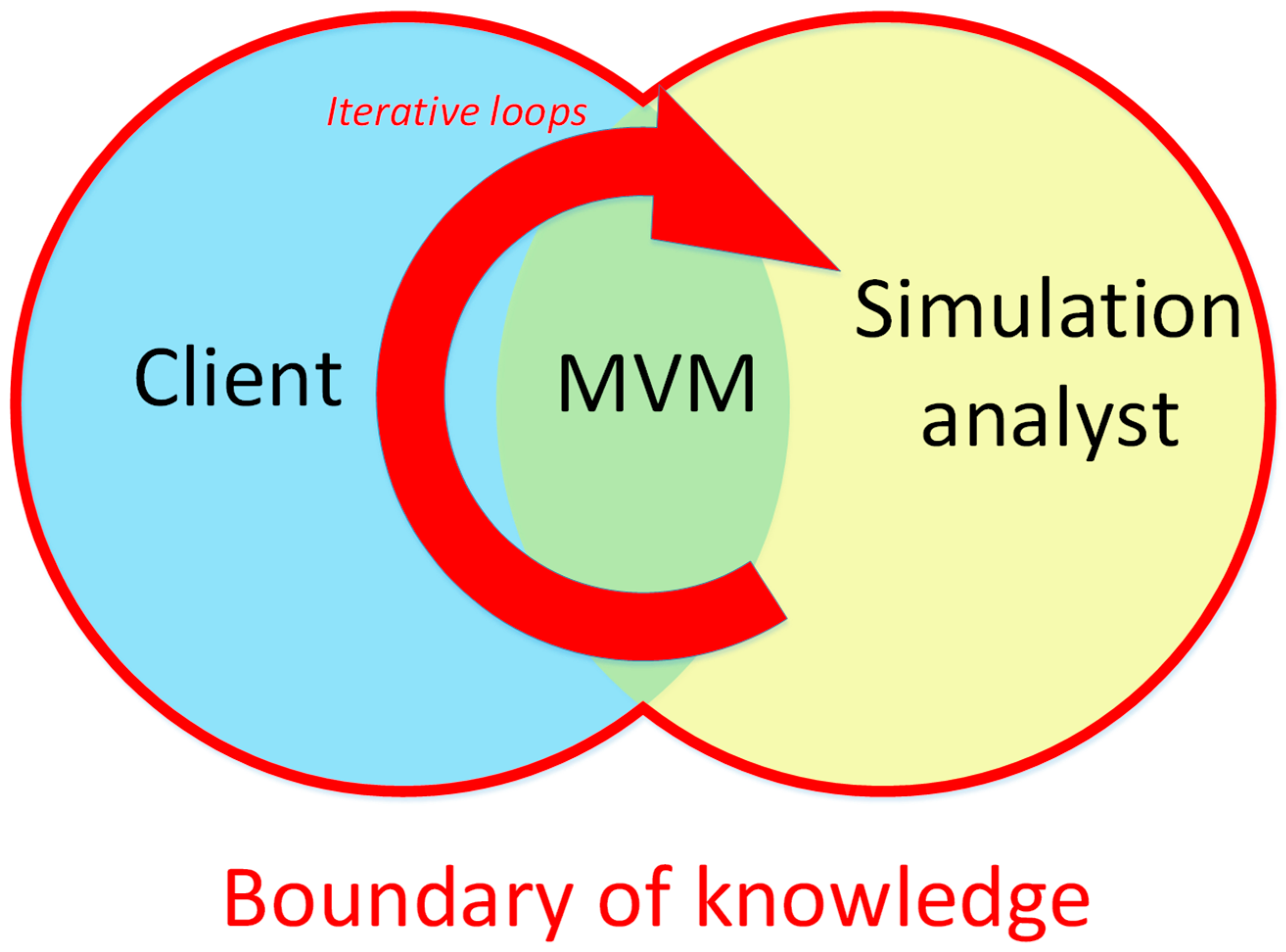

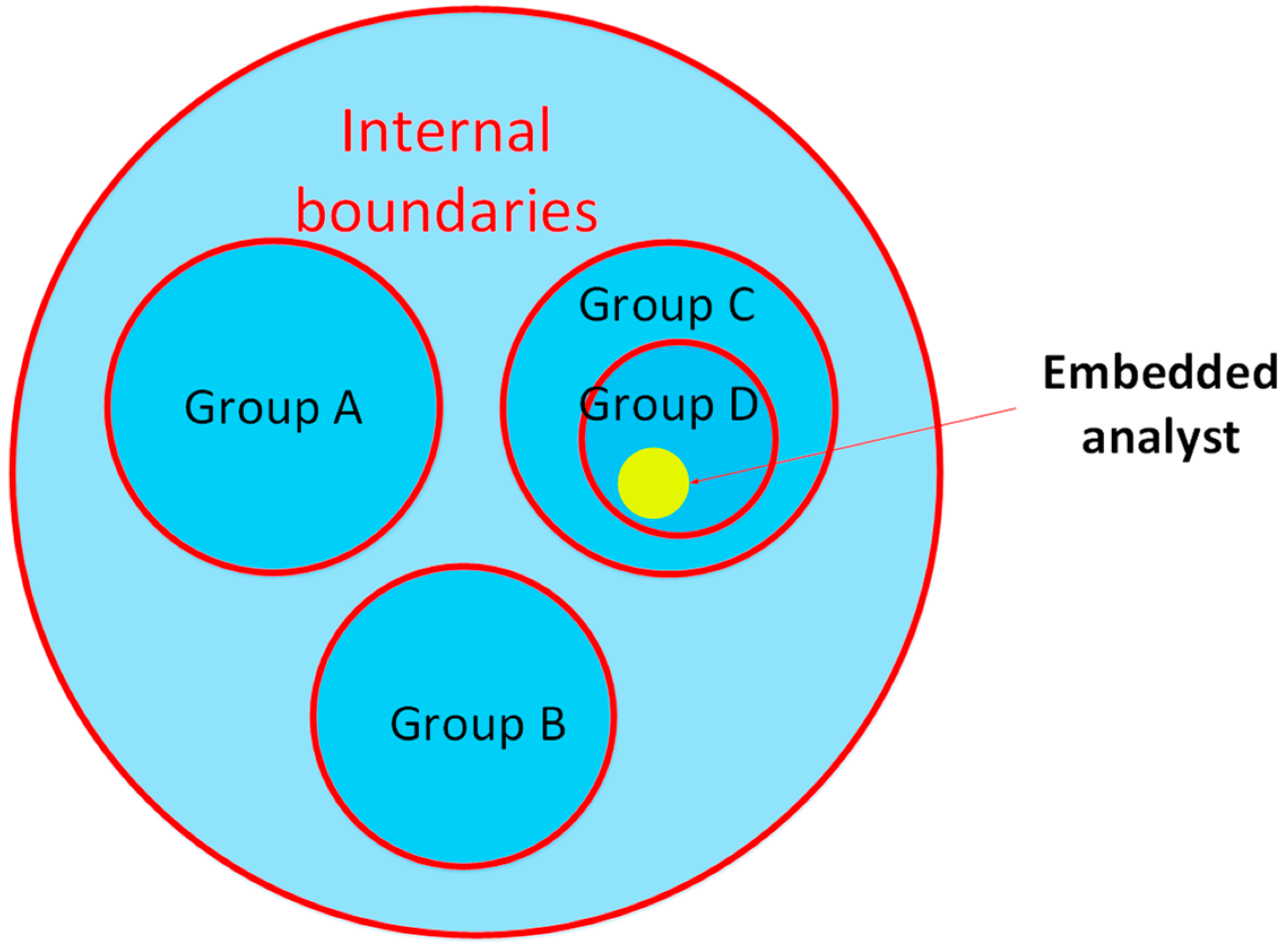
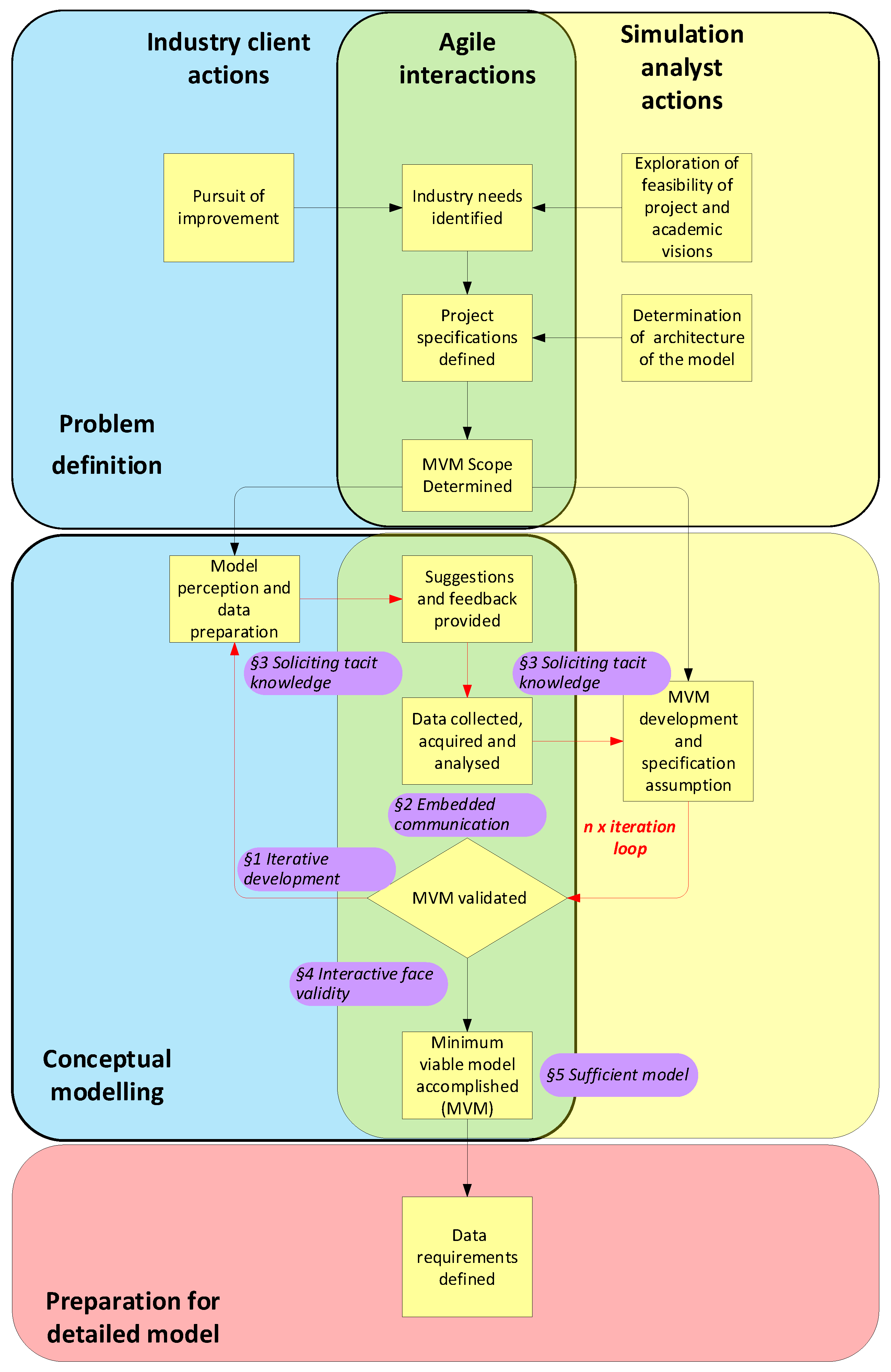

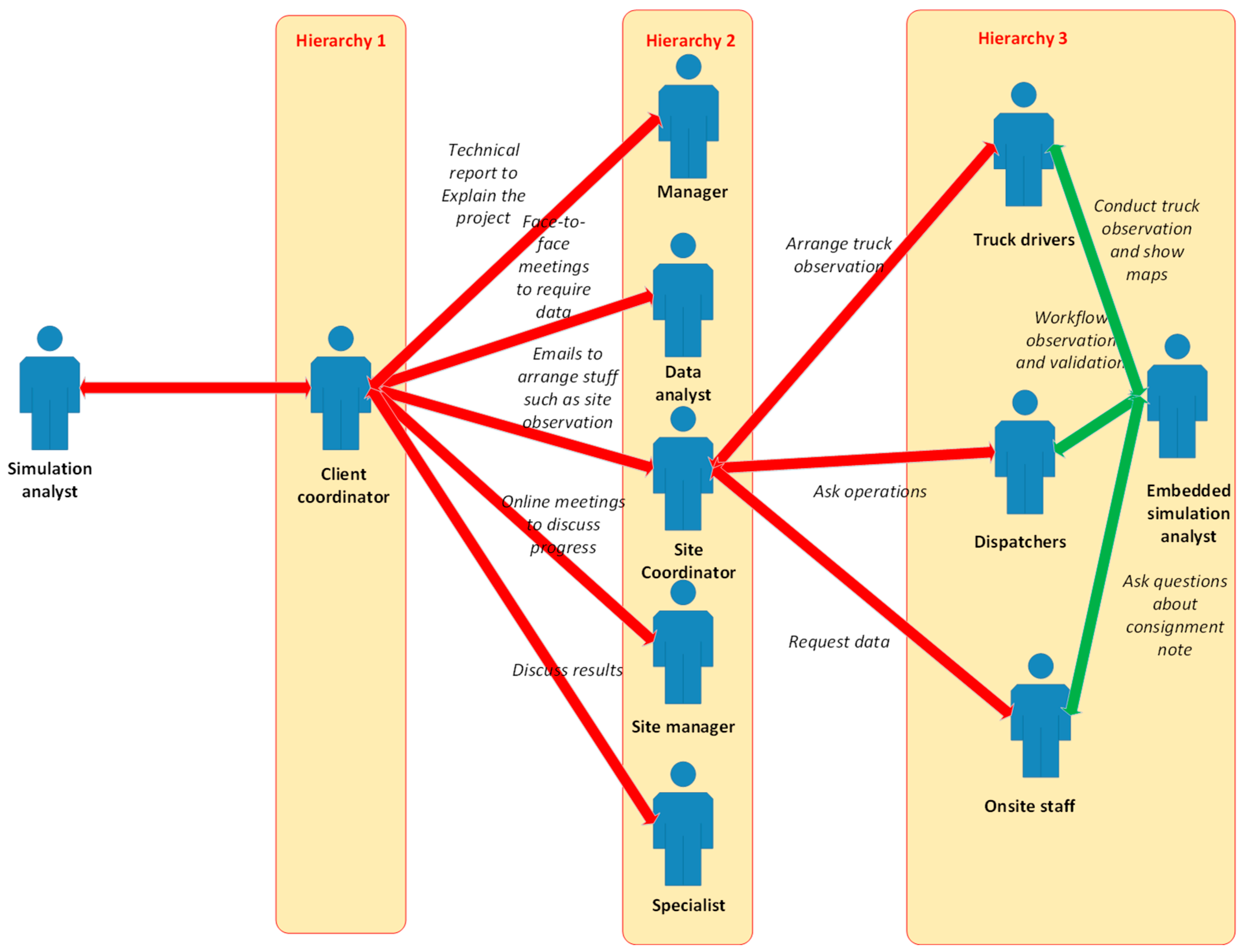
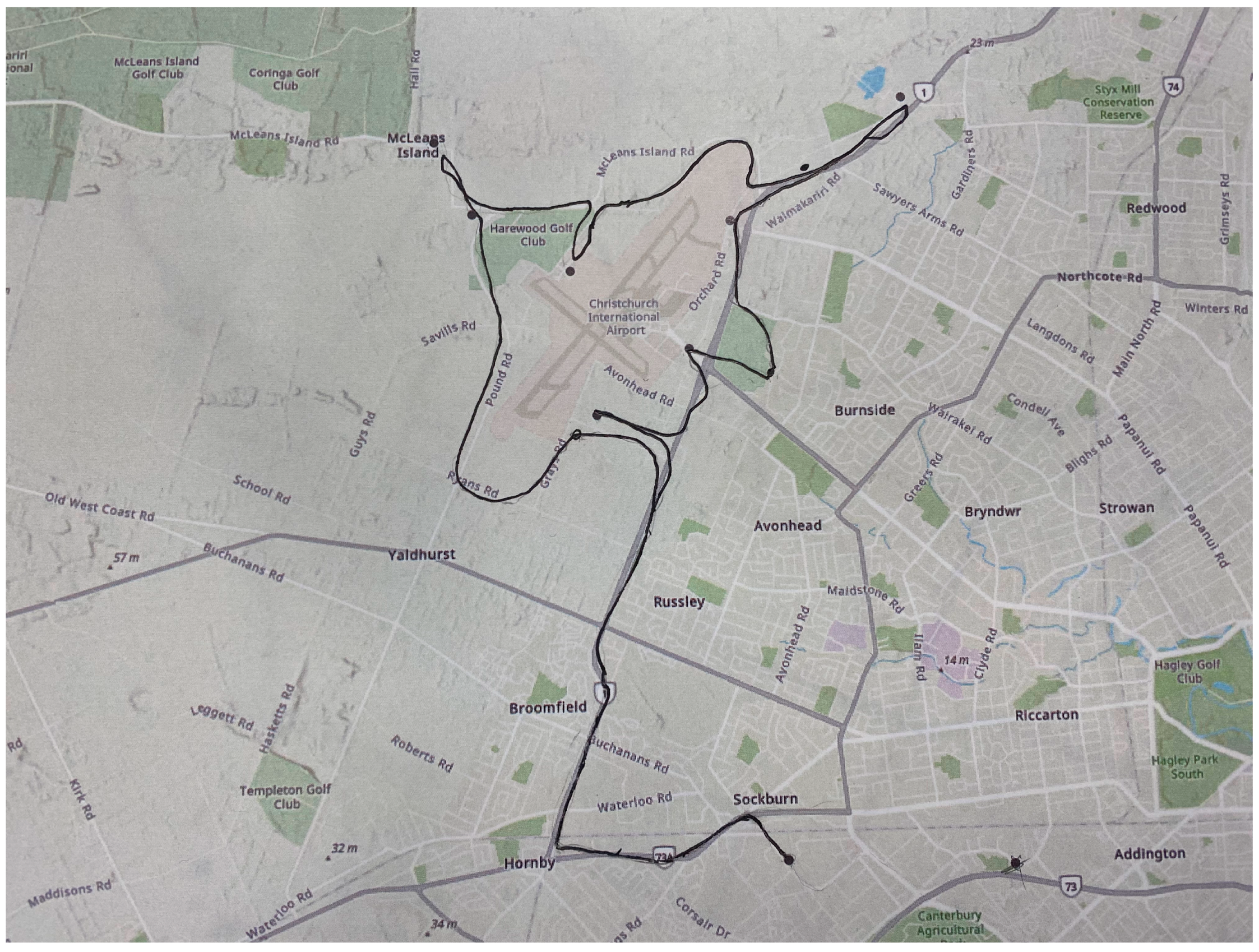
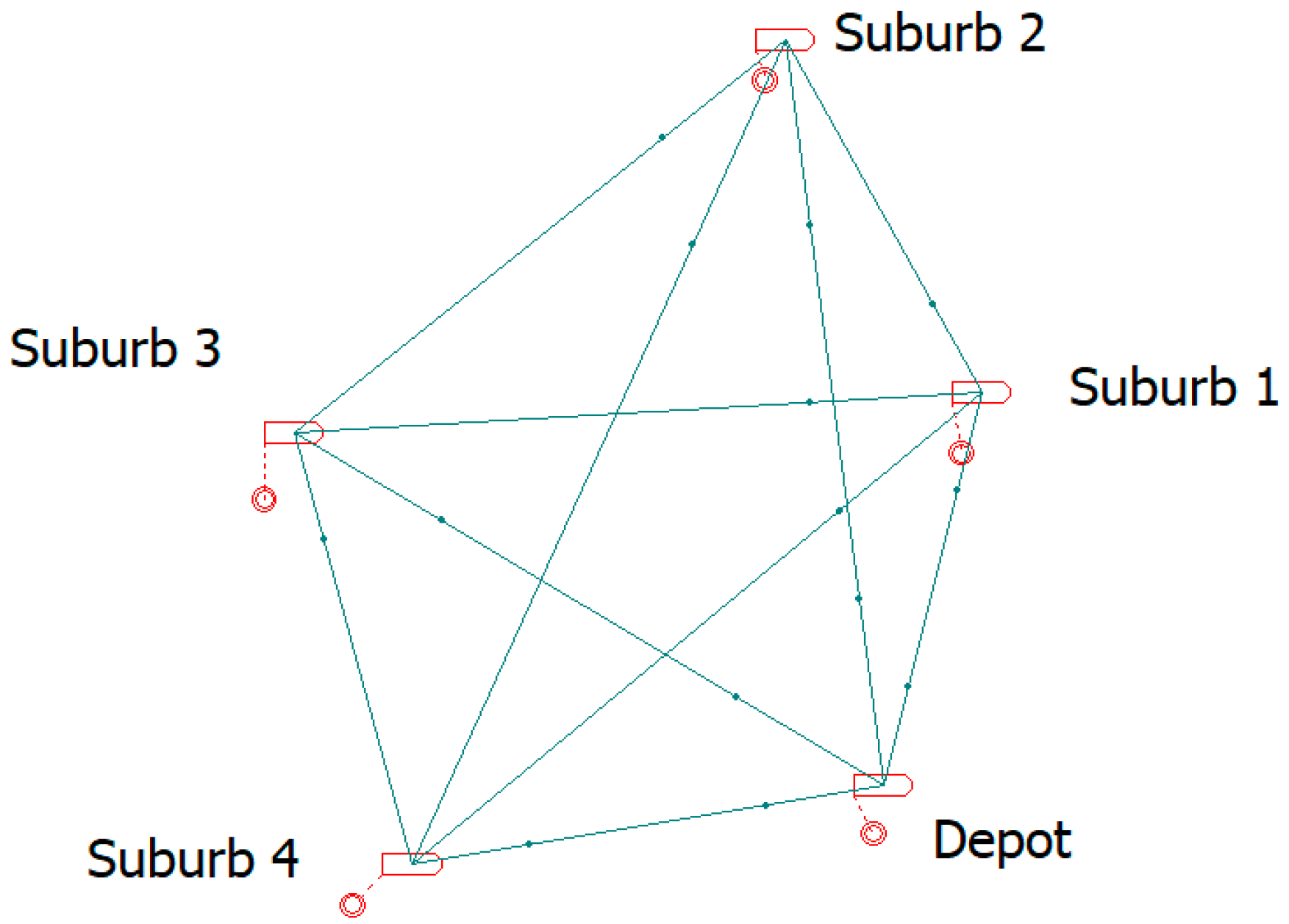

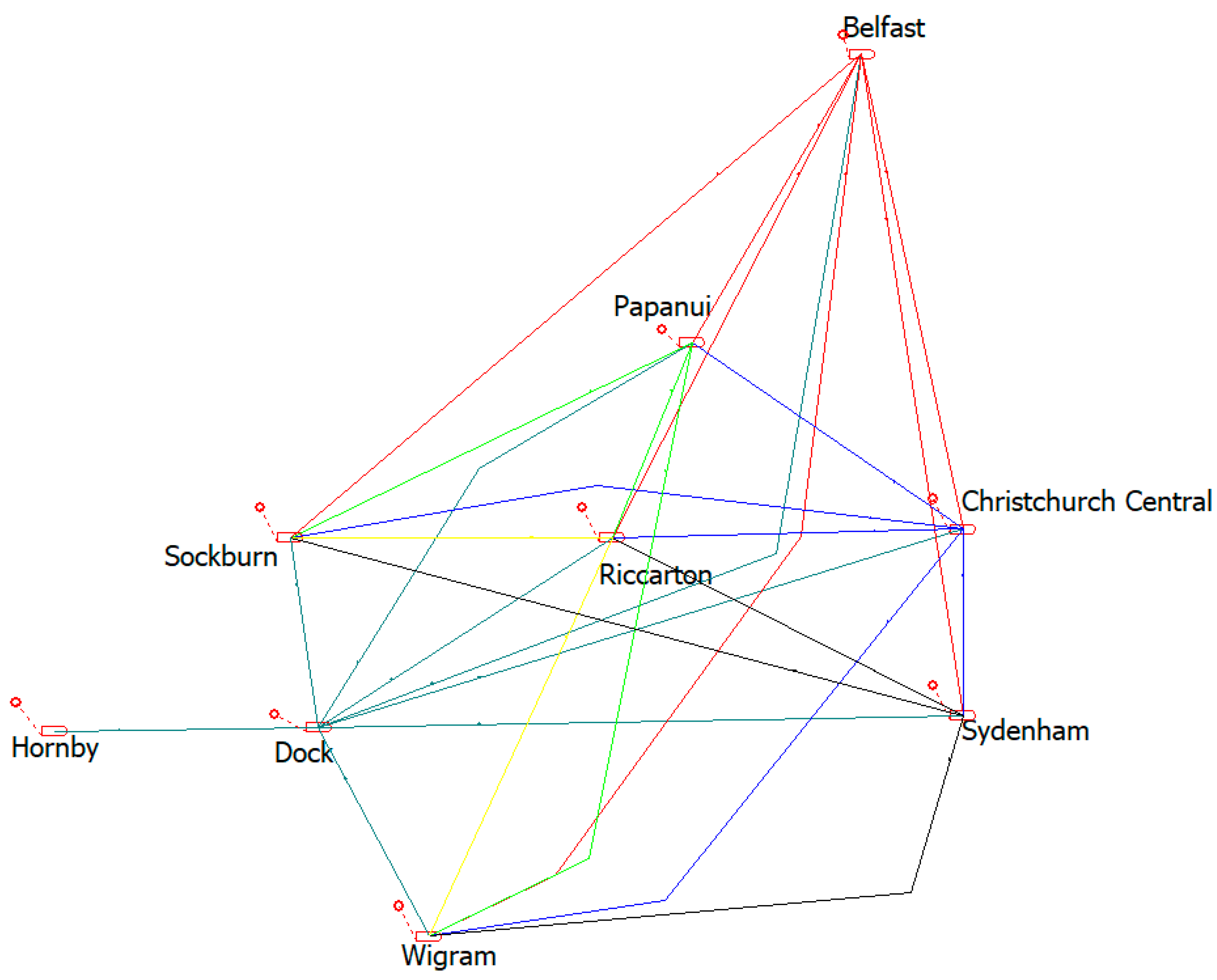
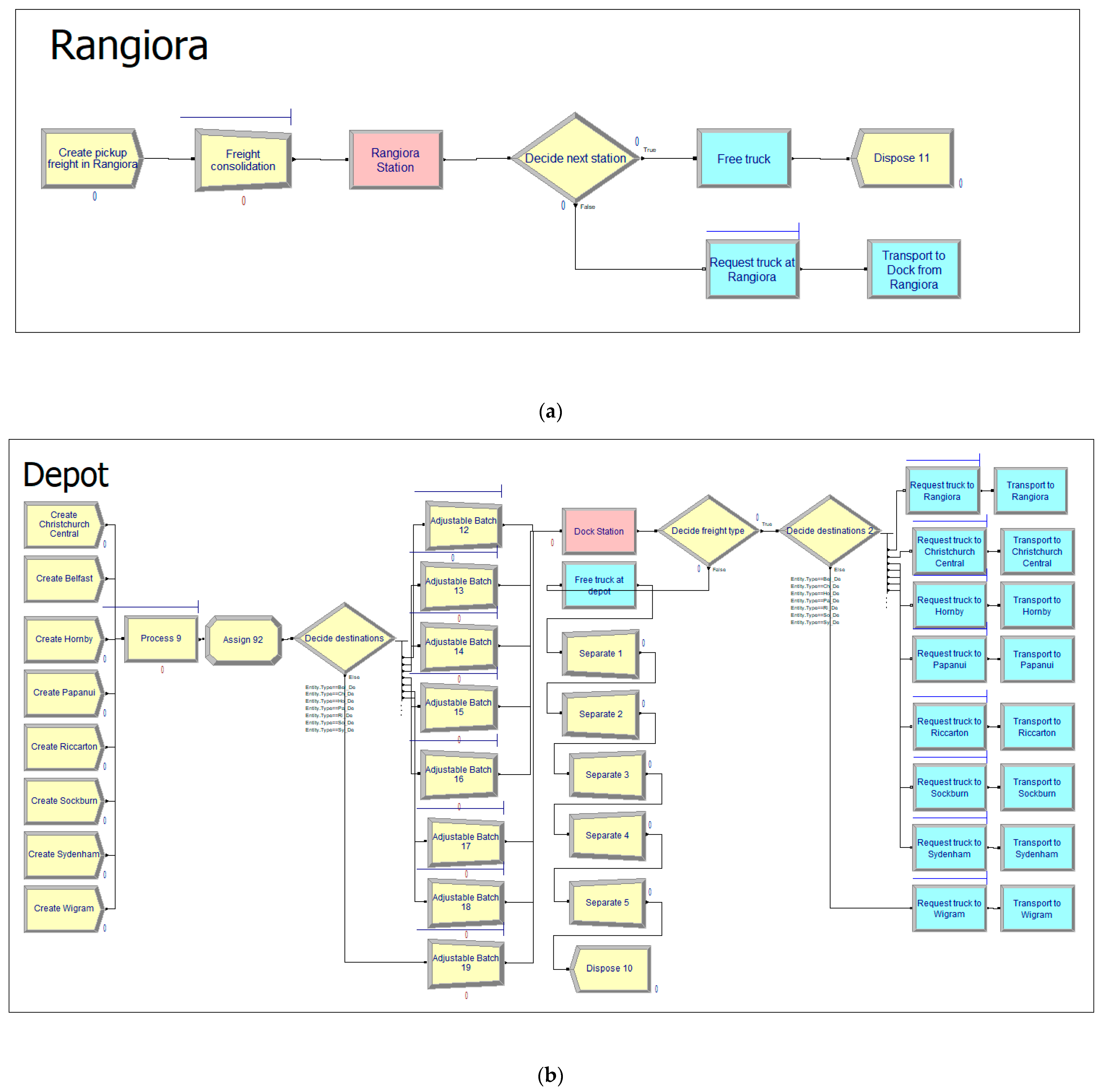
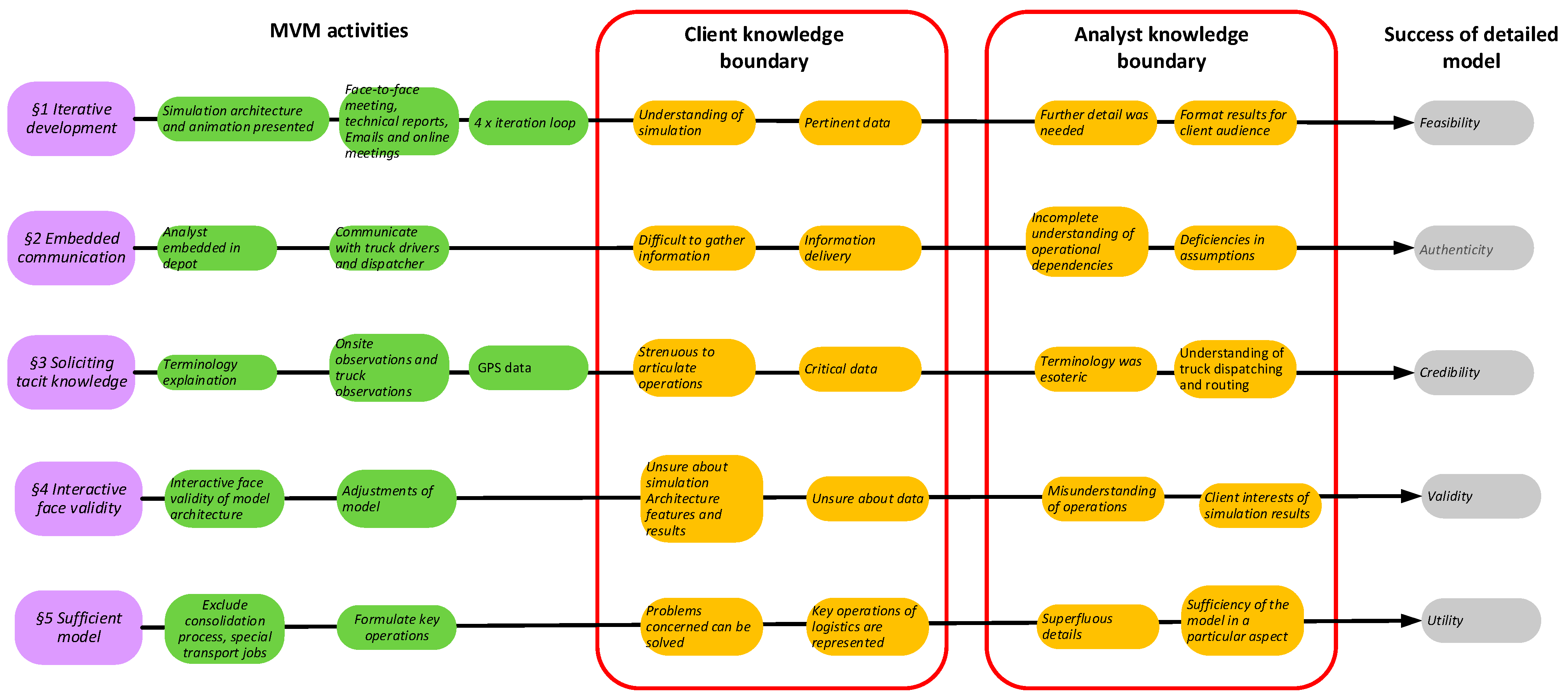
| Tacit Knowledge Solicited | Question from the Analyst | Client Comment or Reply | Further Questions from the Analyst | Further Answers from the Client | Response to the Model |
|---|---|---|---|---|---|
| Truck fleet and service areas | ‘Both trucks and vans are using. I may add vans to the model, so I need the configuration of vans if you have.’ | ‘Vans are a relatively insignificant method of transport for us, they don’t actually fit our desired profile of freight which is B2B. I wouldn’t worry too much about vans but I can provide some detail if desired.’ | ‘I thought you use vans to transport residual freights or small volumes to some remote destinations. Do you have the information about the truck volume limit and pallets? Through my observation, you put most freights on pallets and there is a limit of the pallet. I think I cannot just add volume up and I should consider the arrangement for pallets.’ | ‘No, freight is managed by area. Vans are seldom used for overflow (mostly for unusual freight or very urgent deliveries) instead where excess freight can’t justify another truck load (perhaps one or 2 pallets) then it would wait until the next day. 6 wheeler (standard PUD truck) would be 12 pallet spaces and 12 tonne Truck and trailer (intercity, direct deliveries or larger delivery areas) would be 24 pallet spaces and 24 tonnes Note some pallets can be double stacked meaning pallet spaces aren’t so much a limitation but some dimensions also mean that practically speaking it’s not always possible to reach max tonne capacity. Most freight is on pallets, smaller items like cartons for multiple orders would be consolidated on a pallet as far as loading is concerned.’ | The fleet of trucks was considered as the client described. The capacity of the truck was included in the consolidation process. |
| Analyst’s Questions | Client’s Comment or Reply | Further Actions |
|---|---|---|
| ‘Does this model adequate represent the core operational processes for your organisation?’ | ‘Perhaps, but would like to discuss further some of the underlying assumptions.’ | The analyst modified the model and discussed it with the client. |
| ‘What features in this model do you view positively?’ | ‘Good first attempt at defining modelling logic for an operation that is complex and dynamic. Batching is a practical equivalent to our dispatching process. Outputs as time, distance, waiting time, occupied trucks and consumption are all practical measures that can point towards optimisation initiatives.’ | Consolidation was considered to add to the future detailed model but not to this MVM due to the sufficient model consideration. |
| ‘What features in this model are weak?’ | ‘An area-based/hub and spoke model is probably more suited than shared routes. To do this we may need to define which areas can and can’t be done by given trucks.’ | The suburbs for trucks were specified in the model. Some suburbs that had fewer consignments were ignored. |
| ‘What additional features should be included for a minimal viable model?’ | ‘Weight and cubic volume are fairly fundamental, more so than the number of items which may entail a 1 kg carton or a 1000 kg pallet. Otherwise, I think feature wise we may be close it is just working around documenting process and assumptions and formatting report/findings they can make the model more clear.’ | Weight and volume limits were involved in the future detailed model but not in this MVM due to the sufficient model consideration. They will be included in the detailed model. |
| ‘Is the operational pattern reasonably realistic? Are there other operational patterns the organisation sometimes uses?’ | ‘There are numerous operational patterns but the vast majority are covered by 2 key activities PUD and LH. While these have numerous variations in and of themselves a generalised base view of these two will account for 90% of volumes moved.’ | Except for PUD and LH transports, other transport patterns were excluded, such as metro freight and B2B. |
| Freight Operations | Initial Model—Basic Model as Initially Discussed with Client | Refined MVM |
|---|---|---|
| Consignments | Only pickup | Pickup and delivery separately |
| Truck speed | New Zealand Transport Agency data | Real GPS data |
| Truck allocation | No specific routes | Based on customer clusters |
| Routing areas | Based on the anticlockwise direction | Based on the hierarchy of suburbs |
| Freight consolidation | Consolidated all consignments | Consolidated consignments based on destinations |
| Freight loading and unloading time | Not considered | Considered |
| Blocks | Description | Complexity Identified by MVM |
|---|---|---|
 | Create block for creating consignments | Discrete distribution for the number of consignments (pickup and delivery) per day for each suburb; first creation time |
 | Process block for freight loading and unloading | Number of forklifts, capacity of forklifts, and process time |
 | Assign block for freight attributes | Weight and volume of each consignment and number of pallets—this was highly variable |
 | Decide block for determining consignment destination | Identification of destinations based on consignment types |
 | Batch block for pickup or delivery freight based on destinations | Weight and volume limits of trucks—in general, a freight company will have a fleet with mixed capabilities |
 | Request block for assigning trucks | Priority of pickup and delivery, FIFO, truck fleets, and driver break times |
 | Transport block for truck movement | Truck routes and truck speed according to GPS data |
 | Station block for representing suburbs | Identification of customer clusters |
 | Process block for truck dispatching | Number of dispatchers and truck dispatching time |
 | Assign block for intrasuburb distance | Intrasuburb travel distance could be obtained from the travelling salesman algorithm in a geographical information system (GIS) |
Publisher’s Note: MDPI stays neutral with regard to jurisdictional claims in published maps and institutional affiliations. |
© 2022 by the authors. Licensee MDPI, Basel, Switzerland. This article is an open access article distributed under the terms and conditions of the Creative Commons Attribution (CC BY) license (https://creativecommons.org/licenses/by/4.0/).
Share and Cite
Lyu, Z.; Pons, D.; Zhang, Y.; Ji, Z. Minimum Viable Model (MVM) Methodology for Integration of Agile Methods into Operational Simulation of Logistics. Logistics 2022, 6, 37. https://doi.org/10.3390/logistics6020037
Lyu Z, Pons D, Zhang Y, Ji Z. Minimum Viable Model (MVM) Methodology for Integration of Agile Methods into Operational Simulation of Logistics. Logistics. 2022; 6(2):37. https://doi.org/10.3390/logistics6020037
Chicago/Turabian StyleLyu, Zichong, Dirk Pons, Yilei Zhang, and Zuzhen Ji. 2022. "Minimum Viable Model (MVM) Methodology for Integration of Agile Methods into Operational Simulation of Logistics" Logistics 6, no. 2: 37. https://doi.org/10.3390/logistics6020037
APA StyleLyu, Z., Pons, D., Zhang, Y., & Ji, Z. (2022). Minimum Viable Model (MVM) Methodology for Integration of Agile Methods into Operational Simulation of Logistics. Logistics, 6(2), 37. https://doi.org/10.3390/logistics6020037








